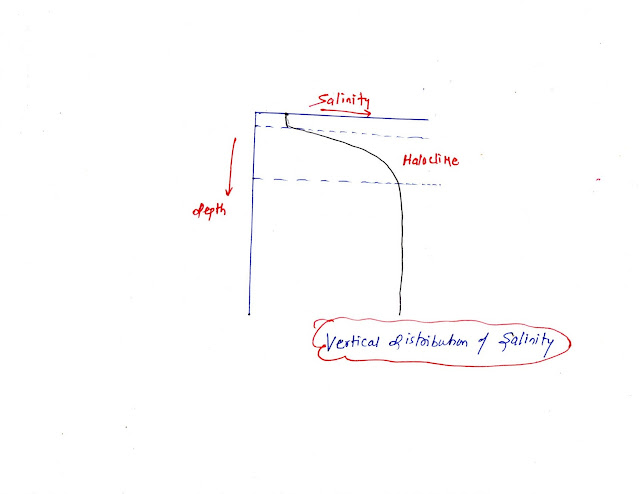The salinity of the oceans water:
The salinity of the ocean's water can be measured as the total salt contains in the 1000 grams of seawater. If dissolved salt is more than 24.7 grams per 1000 grams of water.
The following factors affecting the ocean salinity:
- The salinity of surface water depends mainly on evaporation and precipitation.
- In the coastal regions, surface ocean salinity greatly influences by the fresh inflow of water from rivers.
- In the polar region, it greatly affects the freezing and thawing of the ice.
- Winds also transfer sea salinity to other parts.
- Ocean current also contributes to salinity variations.
Salinity, temperature, the density of water are interrelated. Temperature and density are greatly related to salinity. Any changes in the temperature and density of water reflect the salinity of the ocean.
Horizontal distribution of Salinity:
- Normal ocean salinity is generally between 33 to 37.
- In the landlock such as the Red sea, it is recorded 41 due to higher evaporation.
- Estuaries and Arctic sea, it fluctuates between 0 to 35.
- In the hot and dry regions where the evaporation of water is high, it may reach 70.
In the Pacific Ocean:
- North Western Pacific, salinity decrease from 35 to 31 because of the fresh influx of melted water from the Arctic ocean.
- In the southern Pacific, salinity also decreases due to the fresh influx of melted water from Antarctica.
Atlantic Ocean:
- Salinity is around 36.
- Higher salinity is recorded in 15 to 20 degrees latitude due to higher evaporation and a decrease in the freshwater infusion from the dry region.
- Salinity gradually decreases towards the north.
- In the north sea, despite having higher latitude, salinity increases due to the influx of saline water brought by North Atlantic drift.
- Baltic sea records low salinity due to the influx of river water by a large quantity.
- In the Mediterranean sea, very high salinity was recorded due to higher evaporation.
- Very low salinity is recorded in the Black sea due to the higher influx of river water.
Indian Ocean:
- The average salinity is 35.
- Low Salinity is recorded in the Bay of Bengal due to the high influx of river water.
- High Salinity is recorded in the Arabian Sea due to the low influx of fresh water in the Arabian Sea.
Vertical Distribution of Salinity:
- Location and depth of the ocean, both matter for salinity.
- Salinity at the surface get decreases by freshwater input or get increase by loss of water to evaporation and Ice.
- Salinity in the depth is very much fixed as there is no water adds or loss.
- Salinity generally increases with an increase in depth.
- There is a distinct zone called Halocline, in this zone, there is a sharp increase of salinity.
- An increase in salinity causes an increase in density which leads to a sink of saline water that leads to stratification of salinity.
- High saline water is heavier in nature and they sink. Coldwater is also heavier and sinks at the poles.
- Ocean water from the bottom moves from the poles to the equator. Surface water moves from the equator to the poles.
- Ocean water is heavier than fresh water and that enables plankton to float on the water surface. Without plankton, the entire ocean ecosystem will collapse,
For a detailed explanation, watch the below video:





ConversionConversion EmoticonEmoticon